Potted Christmas trees are a fantastic option for indoors and they can be saved if they start to wither away. Soak your tree in liquid seaweed, add slow release fertilizer, place it in a protected position outdoors, and repot it if it’s root-bound. This will help your tree recover and flourish for the next holiday season. With the right care, potted Christmas trees can last for up to three years, saving you money and reducing waste.

Indoor Christmas trees can suffer especially if they have been kept near in indoor heat source like a fire or heater. If you think your potted Christmas tree is dying you can revive it if you follow a few easy steps.
How to know your potted Christmas tree is dying
Look out for signs that your potted Christmas tree is no longer thriving. Here are 10 signs that you need to take action to save your potted tree.
- Brown or yellowing leaves
- Drooping branches
- Dry, brittle needles that fall off easily
- Lack of new growth
- Excessive shedding of needles or leaves
- Stunted growth
- Brittle or mushy root systems
- Discoloration of the trunk or branches
- Pests or infestations
- Foul odor or mold growth
9 Steps to revive a dying potted Christmas tree
Here are my 9 easy steps to help your dying potted Christmas tree recover.
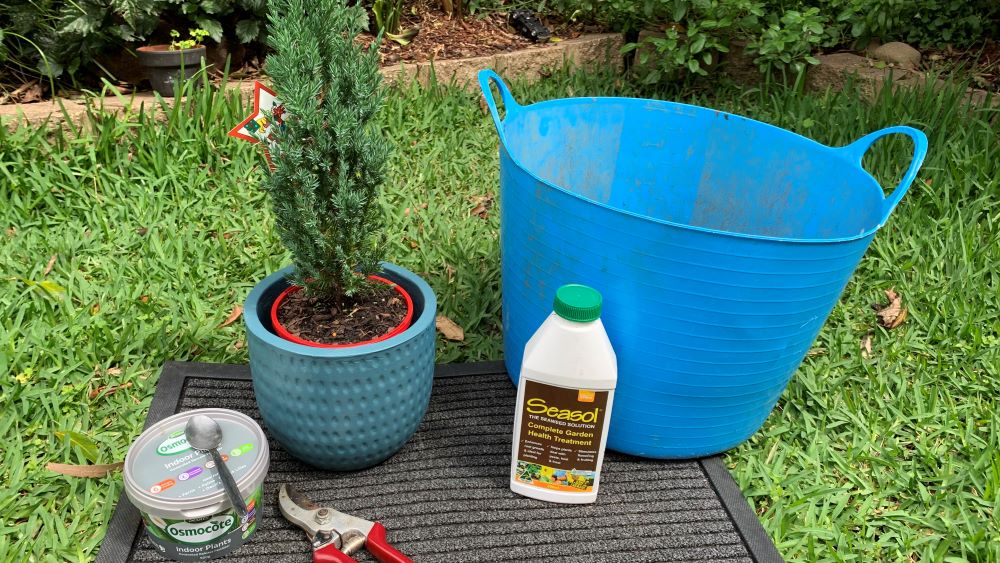
1. Prepare your items
To revive your potted Christmas tree, you need some essential items. You will need:
- Sharp, clean secateurs
- Indoor plant food or slow release organic pelleted chicken manure
- Bucket
- Seaweed solution
- Water
Remove any string lights before taking your Christmas tree outside to avoid getting them wet or damaged.
2. Trim off any damaged stems
The first step to tidy up your potted Christmas tree is to trim off any damaged stems and leaf tips. Trimming off brown or damaged stems will give the plant more room to grow new stems and for the healthy green leaves to photosynthesize.
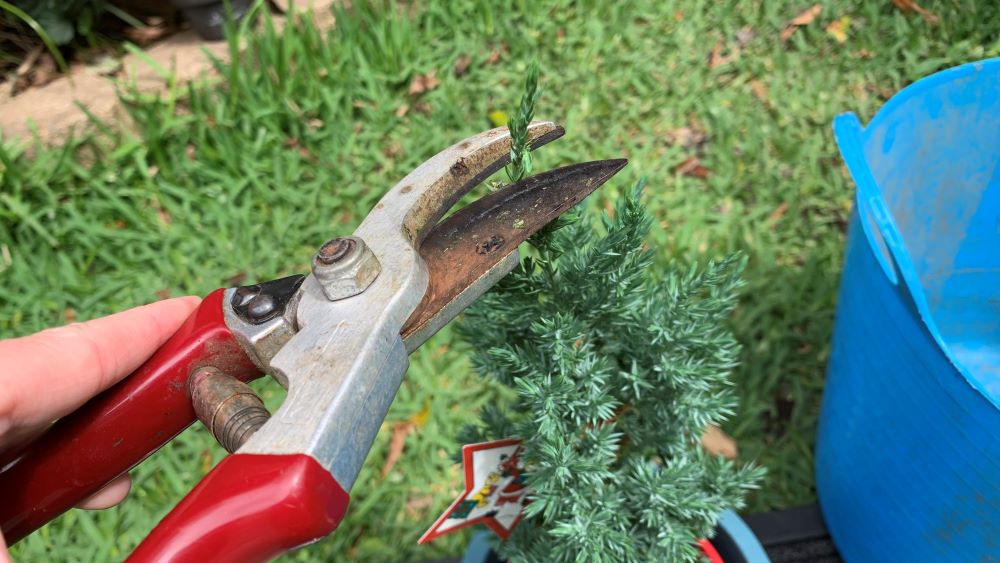
3. Soak it in liquid seaweed
Soak your potted Christmas tree in a bucket of diluted liquid seaweed for 5-10 minutes. The root tonic in seaweed will help revive any damaged roots, and the water will hydrate the soil.
Add water into a bucket so that it is just under the top of the pot. Add a dash of liquid seaweed and let the pot soak.
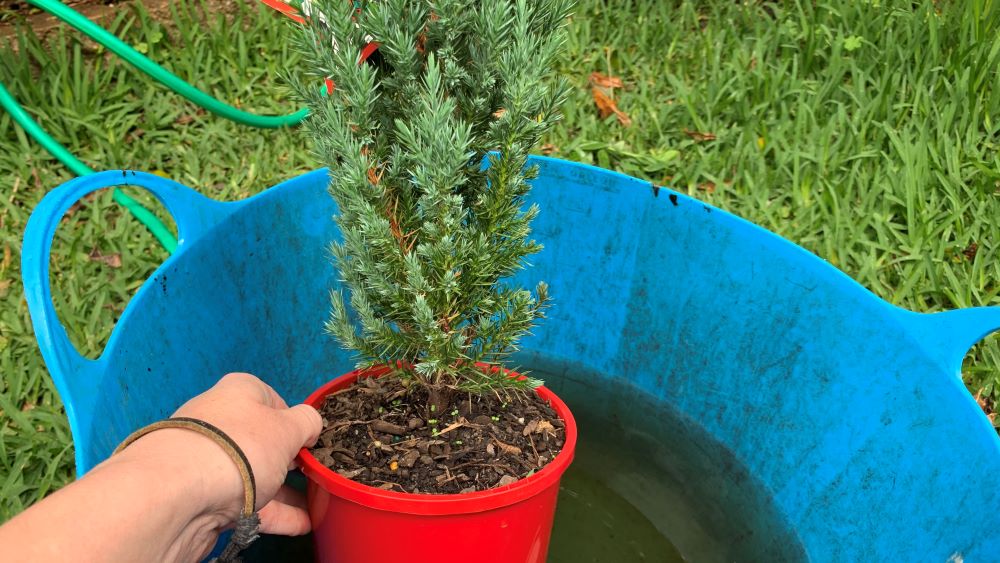
Take the pot out of the bucket of water and allow it to drain thoroughly. Leave it outdoors for at least 10 minutes to let all of the extra water drain out. This is a great way to rehydrate the soil if you have let your tree dry out too much and the soil has become hydrophobic.
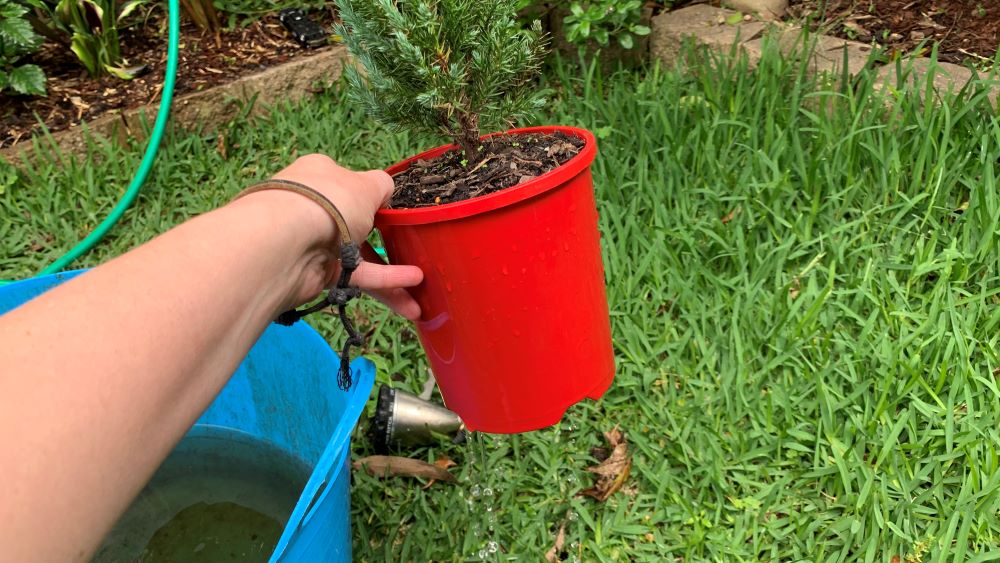
4. Add some organic slow release fertilizer
Add slow-release fertilizer that contains organic matter or an indoor slow-release plant food to your Christmas tree to help it recover. You can use pelleted chicken manure for outdoor trees and indoor slow-release plant food for indoor trees.
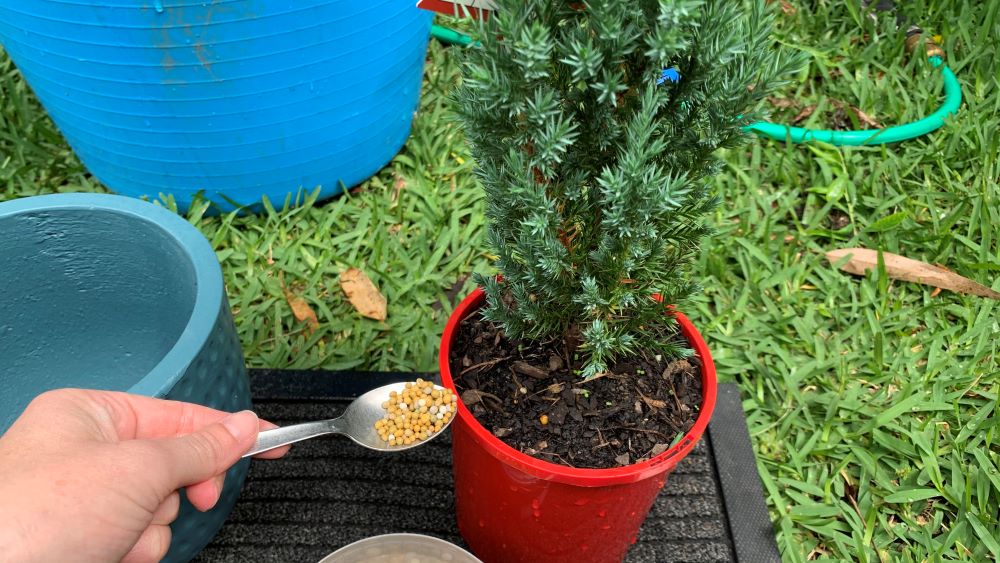
If you are bringing your Christmas tree back indoors then use a slow release indoor plant food to avoid any smells in your home. Water it in to start to release the nutrients to the plant.
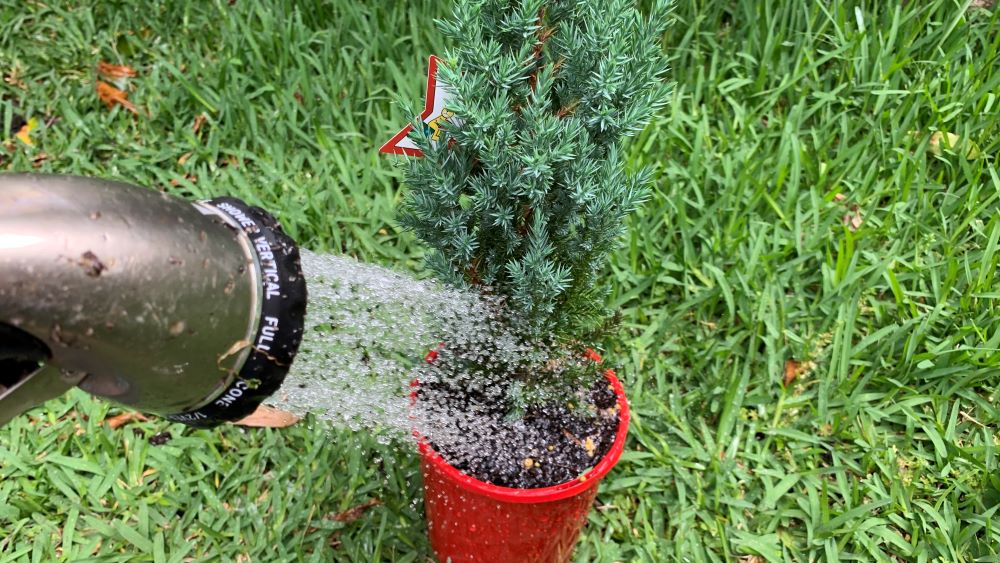
5. Leave the plant in a protected position for 2 weeks
Move your Christmas tree outdoors to a protected position where it can get more light and adjust to the outdoor climate. Avoid putting your plant in direct sunlight for 2 weeks until it adjusts to beign outdoors.
Make sure the pot is lifted off the ground slightly so that the plant has adequate drainage. If it is very cold outside, consider moving the tree to a greenhouse. Alternatively, you can place it in a protected position under a verandah that gets at least six hours of bright sunlight.
If you live in the northern hemisphere and you are experiencing very cold weather you will need to provide your Christmas tree with protection. Moving the tree to a greenhouse might be the best option if you are getting snow. Pine trees or juniper trees are frost tolerant but will not transition well from a very warm indoor environment to outdoors.
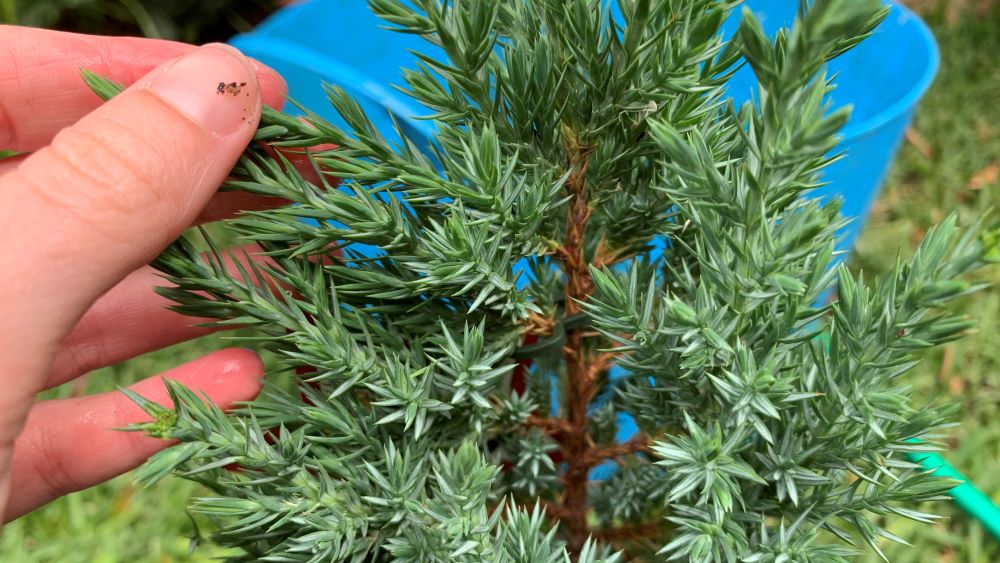
If your weather is still very cold, you can move your plant into a protected position under a verandah, as long as it is getting at least 6 hours of sunlight. Very often the cause of damage to your indoor Christmas tree is a lack of light.
6. Repot the plant if it is root bound
If your potted Christmas tree is pot-bound, it’s time to repot it. If you notice roots coming out of the bottom of the pot or the pot feels firm, it’s a sign that the tree needs more space. Repot the tree in a pot that is two inches wider and deeper than the current one.
Take the Christmas tree out of the pot, loosen the root ball and trim off any damaged roots. You can then move the plant to a new pot. Use a good quality potting soil and water it in well.
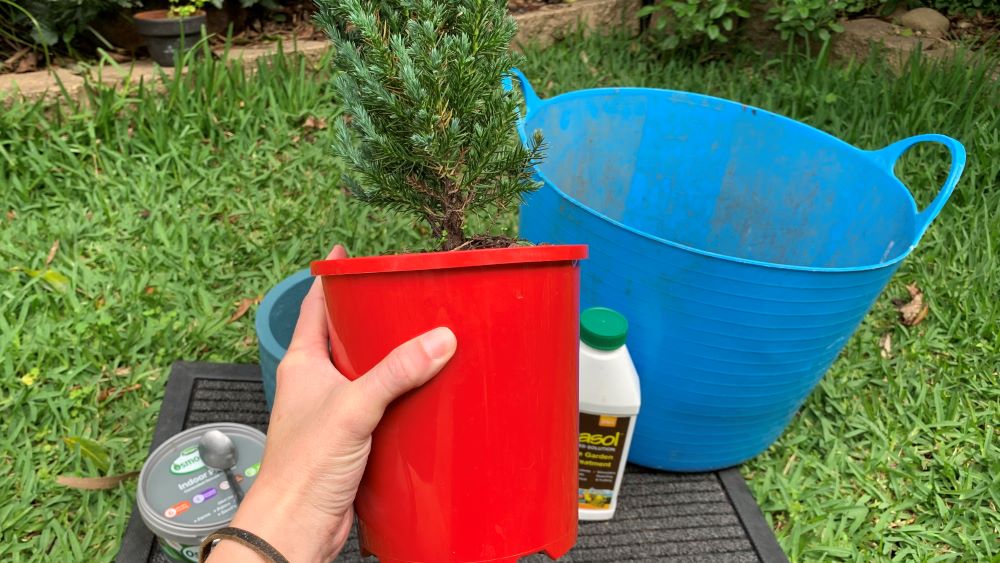
7. Mulch the top of the soil
The final step to protect your plant is to mulch the top of the pot. Use a fine bark mulch on top the plant to help to protect the soil from drying out. You can also use coconut coir or straw if you have some.
Once you see signs that your plant is growing new leaves then you know that you know you have addressed the problem. You may need to wait until spring if the weather is cold before you see new leaves.
8. Monitor the Progress
Wait for a few weeks to see the progress. Your Christmas tree will show new signs of growth and green leaves if the treatment is successful.
9. Enjoy Your Revived Potted Christmas Tree
Your potted Christmas tree is now revived and ready to brighten up your holiday season. Admire your beautiful plant, and don’t forget to water it regularly to keep it healthy.
For more tips on caring for a potted Christmas tree, check out this video.
How to stop your potted Christmas tree from dying
Here are a few tips to help to avoid your Christmas tree dying indoors. Firstly, keep it away from direct heat sources. Fireplaces and heating units will dry the leaves and the roots out rapidly and can quickly kill your plant.
Use low wattage LED lights on your Christmas tree. This will help to avoid heating up the leaves which can quickly cause damage. Add small amounts of water to your tree regularly to keep it healthy.
Avoid exposing your potted Christmas tree to excessive sun. Move it away from windows that get direct afternoon sun as it can scold the leaves.
Avoid placing your Christmas tree in drafty areas. This can quickly dry out the soil and the plant can quickly die. Instead place it in a protected area indoors that gets bright light but is away from heat sources.
How to Revive a Dying Potted Christmas Tree | Summary
Potted Christmas trees make a wonderful gift for your loved ones or a perfect addition to your holiday decor. It is important to keep an eye on your tree to make sure stays vibrant throughout the season. To save your tree, make sure you keep the soil moist and give it a slow-release fertilizer to promote healthy growth. These steps will give you a beautiful and lively Christmas tree.
Happy growing.
I am an accredited practicing dietitian, experienced gardener and a dedicated cook. I love writing and sharing my experience so you can learn from my successes and mistakes.
